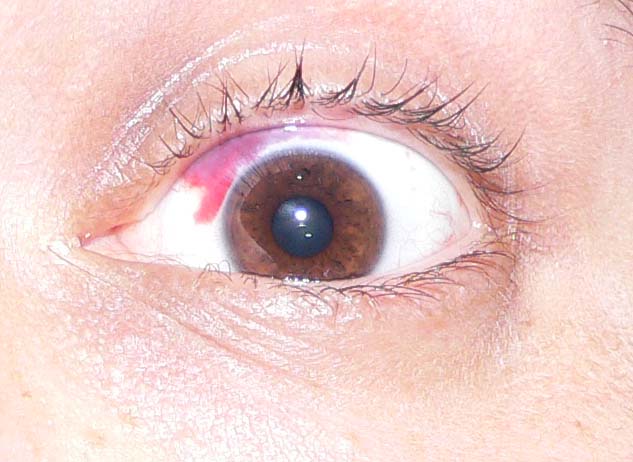Intraocular hemorrhage
| Intraocular hemorrhage | |
 |
|---|
Editor-In-Chief: C. Michael Gibson, M.S., M.D. [1]Associate Editor(s)-in-Chief: Luke Rusowicz-Orazem, B.S.
Ocular Anatomy
The volume of the vitreous in the adult is about 4 cc or 80% of the volume of the eye's globe. Water makes up 99% of the vitreous content. The remaining 1% mostly is composed of collagen and hyaluronic acid which although clear, causes the vitreous to be gelatinous.
The vitreous is attached to the retina in three locations. The vitreous base refers to a 4 mm circular band where the vitreous body attaches to the anterior retina (ora serrata). This is the strongest of the three attachments. The vitreous also attaches in a circular zone around the optic nerve head. This is the second strongest attachment of the vitreous. This attachment becomes progressively weaker with advanced age, and it is this attachment that may become separated in posterior vitreous detachment.
The vitreous is itself avascular and therefore the blood in vitreous hemorrhage comes from organs outside the vitreous. When hemorrhage occurs into the vitreous, it accumulates in potential spaces within and around the vitreous body. These potential spaces for blood to accumulate include the following:
- The retrolental space of Erggelet
- The canal of Petit
- The Cloquet canal
- The bursa premacularis
- The canal of Hannover (between the orbiculoanterocapsular and posterocapsular portions of the zonular fibers)
The borders of the vitreous body are as follows:
Posterior: The internal limiting membrane of the retina
Anterior: The nonpigmented epithelium of the ciliary body, and anteriorly by the lens zonular fibers and posterior lens capsule.
Pathophysiology
The two most common overarching pathophysiologic mechanisms of vitreous hemorrhage involve hemorrhage into the vitreous from a diseased retina or trauma. Specific pathophysiologic mechanisms are discussed below:
Extraocular Causes of Vitreal Hemorrhage
Diabetes and sickle cell disease are obvious extraocular diseases that are associated with retinopathy. Retinopathy is characterized by neovascular vessels, fragile vessels, occluded vessels and ischemic vessels, all of which increase the risk of vitreous hemorrhage. The disorders are associated with retinal ischemia which in turn causes the release of angiogenic growth factors including vascular endothelial growth factor (VEGF), basic fibroblast growth factors (bFGF), and insulin-like growth factor (IGF).
Trauma is another major pathophysiologic mechanism of intraocular hemorrhage.
Conditions that may increase the risk of vitreal hemorrhage also include coagulation disorders (e.g. leukemia and thrombocytopenia). While coagulation disorders may not themselves be primarily associated with bleeding, in the presence of trauma or retinopathy they may secondarily increase the risk of bleeding. Autoimmune / collagen vascular disorders such as Behcets disease and sarcoid have also been associated with an increased risk of intraocular hemorrhage. Thus a careful history should be obtained regarding all these systemic / extraocular causes.
Subretinal Bleeeding with Breakthrough Bleeding into the Vitreous
Other less common pathological mechanisms of vitreous hemorrhage include subretinal bleeding with secondary extension into the vitreous cavity.
Age-related macular degeneration and choroidal melanoma are the two leading causes of vitreous hemorrhage secondary to breakthrough bleeding. Terson syndrome is subarachnoid hemorrhage associated with vitreous bleeding caused by rupture of retinal venules and/or capillaries as a result of a sudden increase in intracranial pressure (which is transmitted to the retinal vasculature via the optic nerve).
Subarachnoid Hemorrhage and Associated Intraocular Hemorhhage
Approximately one of three patients with subarachnoid hemorrhage will sustain an intraocular hemorrhage, and approximately 6% of patients have vitreous hemorrhage.
Terson Syndrome
In this condition, the branches of the central retinal vein or the central retinal vein itself are generally the source of intraocular bleeding. This syndrome occurs predominantly in patients aged 30 to 50 years.
Causes
Common Causes
- Proliferative diabetic retinopathy
- Posterior vitreous detachment
- Trauma (blunt or penetrating, including shaken baby syndrome/child abuse)
- Retinal tear
- Central retinal vein occlusion
- Hypertensive retinopathy
- Subarachnoid hemorrhage (Terson syndrome)
- Avulsed retinal vessels
- Age-related macular degeneration
- Radiation retinopathy
- Macroaneurysms
Causes by Organ System
Causes in Alphabetical Order
- Age-related macular degeneration
- Anticoagulants
- Antiphospholipid antibodies
- Astrocytic hamartoma
- Avulsed retinal vessels
- Behçet disease
- Branch retinal artery occlusion
- Cavernous hemangioma
- Central retinal artery occlusion
- Central retinal vein occlusion
- Coats disease
- Congenital prepapillary
- Dermatomyositis
- Disseminated intravascular coagulation
- Dominant exudative vitreoretinopathy
- Drug side effect
- Eales disease
- Globe perforation
- Hemophilia
- High altitude
- Hypertensive retinopathy
- Hyperviscosity syndrome
- Idiopathic thrombocytopenia purpura
- Incontinentia pigmenti
- Inflammation
- Intraocular lens implantation
- Intraocular lens removal
- Intruding scleral buckle
- Leukemia
- Macroaneurysms
- Malignant choroidal melanoma
- Melanocytoma
- Neovascularization
- Norrie disease
- Ocriplasmin
- Ocular ischemic syndrome
- Orbital fracture
- Persistent hyaloid artery
- Pigmentosa valsalva retinopathy
- Posterior vitreous detachment
- Presumed ocular histoplasmosis syndrome
- Proliferative sickle cell retinopathy
- Proliferative diabetic retinopathy
- Protein c deficiency
- Radiation retinopathy
- Retinal angiomatosis
- Retinal detachment
- Retinal macroaneurysm rupture
- Retinal tear
- Retinal laser photocoagulation
- Retinal vasculitis
- Retinitis
- Retinoblastoma
- Retinopathy of prematurity
- Sarcoid posterior uveitis
- Subarachnoid hemorrhage
- Syphilitic retinitis
- Systemic lupus erythematosus
- Talc retinopathy
- Thrombocytopenia
- Thrombolysis
- Thrombotic thrombocytopenic purpura
- Toxocara
- Trabeculectomy
- Trauma
- Tumors
- Uveitis
- Vascular loop venous stasis retinopathy
- Von willebrand syndrome
External Links
References
Template:Eye Template:Visual system Template:Retina Template:Arteries of head and neck Template:Veins of the head and neck